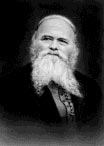alias Eliphas Lévi

(1810 - 1875)
Son of a shoemaker, Alphonse Charles Constant was born in Paris on the 8th
of February 1810. Brilliant student, he is selected as a potential candidate
for the Priesthood in the Roman Catholic Church. He receives the Minor Orders,
then the Diaconate on December 19, 1835, and should have been a Priest the
following year, but he meets a young woman who, as he wrote later, "initiated
him to life". She was Flora Tristan, an activist for women's liberation
and promoter of collectivism. The painter Gauguin was her grandson.
The young man became attracted by monastic life. He entered the famous monastery
of Solesmes in July 1838, where he studied Gnosticisme, the Early Fathers,
George Sand, and the then still unknown works of Mme Guyon.
Following an argument with Father Abbot, dom Guéranguer, he left
the monastery in 1840, and works as a playground monitor, while writing
his first book: The Bible of Freedom developping the ideas of the Liberal
Catholic Lammenais. The authorities seized the book at the request of the
Roman Catholic Church, and Alphonse was sent to prison for 8 months and
condemned to pay a huge fine. Incapable of paying the fine, he had to stay
another 11 months in jail. Alphonse discover the works of Emmanuel Swedenborg
in the prison's library. Liberated in April 1842, Alphonse survives by selling
his drawings and paintings to tourists. His work is of such a quality, that
he is asked to decorate the church of Choisy-le-Roi.
Alphonse Constant married a young woman in 1846. She had a very independance
character, and soon left him to pursue a carreer as a sculptor, under the
name of Claude Vignon. The marriage was nullified in 1865, as the French
law of the time, prohibited Deacons and Priests to marry. Alphonse dedicated
himself to the defense of Liberalism. He went to prison again for one year
after writing a pamphlet: The Voice of Famine. When released, he learned
that the police had mistakingly murdered one of his neighbours, believing
it was him. He decided to suspend his political activities, and to follow
his second passion: occultism.
He met Hoéne Wronski, and with him joined a cercle of spiritualists,
in particular the Masonic historian Ragon, and the chiromancian Desbarolles.
Encouraged by his new friends, Alphonse Constant publishes the first volume
of Dogme et Rituel de Haute Magie in a series of brochures, which are signed
by the hebrew translation of his two first names: Eliphas Lévi.
Sir E. Bulwer-Lytton, author of the initiatic novel Zanoni, received Eliphas
Lévi into the Martinist and Rosicrucian Brotherhoods and conferring
upon him the Baptism of Light, at the 1854 Spring Equinox, in London. The
ordinand made a 21 days retreat and participated in his initiator's theurgical
experiences, invoking Appolonius of Tyana. He received special teachings
from him, which he transmitted in secret communications to his few disciples.
After his return, Eliphas will live in Paris for the remainder of his life.
In a short period of time, he wrote six other books, attempting to transmit
his spirital message. He assembled a small group of students, and adopted
in his relations with them, the motto: "I don't teach, I awaken".
He died on May 31, 1875.
In a letter to Nicholas-Joseph Spedalieri, a Martinist, Lévi writes:
" I have twelve disciples, not all living in Paris. Four, including
you, are my dear friends. One of the others is a Doctor in Berlin; the two
others are great Polish lords. Of these four, you are the most advanced
in Theosophy".
The task of finding the other eight dosciples is arduous. Mrs. Hanska, born
Rzuwuska, who took such a great place in the life of Honoré de Balzac,
and immortalized in his work as "l'Etrangère". Another
was Sir Kenneth Mackenzie: their regular correspondance, nearly over a decade,
offers many hints about the secret teachings. Another English disciple:
Mrs. L. Hutchinson, has published a portion of the teachings in the Martinist
Magazine l'Initiation.
Correspondance between Mary Gebbhard-L'Estrange of French Canadian descent,
the wife of Franz-Joseph Gebhard, silk manufacturer, Banker, and Persian
Consul, at Elberfeld, Bavaria, Germany, with Col. Henry Steel Olcott confirms
that she was one of Eliphas' disciples. She visited him several times in
Paris, and he came to visit her twice in Elberfeld. After the death of Eliphas
Lévi, she was instrumental in the foundation of the Theosophical
Society in Germany, in her own home: Platzhoffstrasse, 12, with her husband
acting as Correspondant Secretary. Mrs. Blavatsky stayed several times in
the Gebhard's home. With Dr. Franz Harmann, Mary and her family, were part
of the small group of early workers in the Theosophical Society in Germany.
Both also contributed in transmitting several traditional lines of Initiation
to the leaders of that Society.
Much of Lévi's work has survived. He left drawings, paintings, books
of songs, about politics, and of course about Initiation and Occultisme.
Many authors consider that he was an original thinker, but he was truly
an important link between the mystics of the 18th century, and the theosophists
of the 20th. He has an influence reaching far outside the bounderies of
his native country. Among those influenced by him are (in alphabetical order):
George Sydney Arundale, Helena Petrovna Blavatsky, the astrologer and martinist
Gustave-Lambert Brahy, Gérard Encausse (Papus), the Gebbhard family,
Stanislas de Guaïta, Franz Hartmann, Marc Haven, Victor-Emile Michelet,
Henry Steel Olcott, Joséphin Péladan, Margaret Pyke, the alchemist
Albert Poisson, Theodor Reuss, Paul Sédir, and John Yarker.